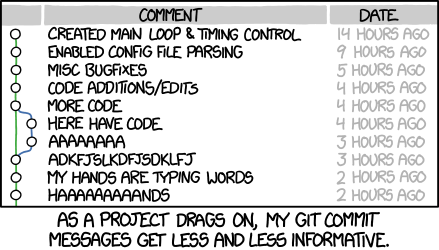Basic Git Workflow¶
The git model¶
The main components to consider when dealing with a simple git workflow are:
- the working directory
- the staging area
- the repository
- the .git directory
We use the various git commmands to move data between these areas. In the image below (taken from the Software Carpentry's Version Control with Git lesson, CC-BY-4.0) we see a file in the Working Directory that has some exisiting lines in black and a new addition in green. git add is used to move the change, the additional green bit, in to the staging area. Once all the changes that make up the logical change have been assembled they are stored in the repositrory with git commit.
Setting up git¶
In order for git to record who made changes we need to configure our name and email address.
$ git config --global user.name "Alice Researcher"
$ git config --global user.email "a.researcher@gw4.ac.uk"There are other configuration options, but these are the only ones we need to set for now.
git status¶
git status is a very handy command for figuring our where you are and what is going on.
If you aren't in a working directory you'll get a message like
train31@myVM:~$ git status
fatal: Not a git repository (or any of the parent directories): .gitOtherwise you'll see something like
train31@myVM1:~/git1/example-basic$ git status
On branch master
Your branch is up-to-date with 'origin/master'.
nothing to commit, working directory cleanWe'll cover branches in few minutes. The last line is what we are looking for.
git diff¶
If we make a change to one of the tracked files in the working directory git will notice
train31@myVM1:~/git1/example-basic$ git status
On branch master
Your branch is up-to-date with 'origin/master'.
Changes not staged for commit:
(use "git add <file>..." to update what will be committed)
(use "git checkout -- <file>..." to discard changes in working directory)
modified: README.md
no changes added to commit (use "git add" and/or "git commit -a")We can examine exactly what the modification was with git diff
train31@myVM1:~/git1/example-basic$ git diff
diff --git a/README.md b/README.md
index cfebfd9..9708379 100644
--- a/README.md
+++ b/README.md
@@ -3,7 +3,9 @@ ex-basic
This repository has just 5 basic commits on master by three different coders, providing a basic commit structure for learning exploring Git commands.
+Adding a new line in the README will be a new commit.
+
## Usage
* Using `git log` to review simple history
-* Filtering `git log` with `--author` option
\ No newline at end of file
+* Filtering `git log` with `--author` optiongit add¶
The command git add takes the changes and moves them to the staging area
train31@myVM1:~/git1/example-basic$ git add README.mdNow the status is
train31@myVM1:~/git1/example-basic$ git status
On branch master
Your branch is up-to-date with 'origin/master'.
Changes to be committed:
(use "git reset HEAD <file>..." to unstage)
modified: README.mdgit commit¶
Git already automatically records
- who
- when
- what
The only thing it can't determine is why. It is up to you do supply the thinking behind the change.
 CC-BY-NC 2.5 Randall Munroe
CC-BY-NC 2.5 Randall Munroe
If it is a particularly simple change and the reasoning is so obvious that you can use a single line to describe it you can use the -m flag
git commit -m "Short Message explaining the commit"Otherwise run
git commitwhich will open up your editor (in the case of this workshop nano, but this can be set with git config --global core.editor )
Here's a screenshot of a commit message in the process of being edited
GNU nano 2.5.3 File: .../train31/git1/example-basic/.git/COMMIT_EDITMSG Modified
Add a line as an example
Here we have a longer description of the commit explaining the
rationale.
# Please enter the commit message for your changes. Lines starting
# with '#' will be ignored, and an empty message aborts the commit.
# On branch master
# Your branch is up-to-date with 'origin/master'.
#
# Changes to be committed:
# modified: README.md
^G Get Help ^O Write Out ^W Where Is ^K Cut Text ^J Justify ^C Cur Pos
^X Exit ^R Read File ^\ Replace ^U Uncut Text ^T To Spell ^_ Go To LineCommit Messsage Best Practice¶
https://chris.beams.io/posts/git-commit/
- Separate subject from body with a blank line
- Limit the subject line to 50 characters
- Capitalize the subject line
- Do not end the subject line with a period
- Use the imperative mood in the subject line
- Wrap the body at 72 characters
- Use the body to explain what and why vs. how
git log¶
train31@myVM1:~/git1/example-basic$ git log -p -1
commit f7a92c7db602425409a5bbb01c6f6d7c3cff9063
Author: Alice Researcher <a.researcher@gw4.ac.uk>
Date: Wed Dec 6 14:39:29 2017 +0000
Add a line as an example
Here we have a longer description of the commit explaining the
rationale.
diff --git a/README.md b/README.md
index cfebfd9..9708379 100644
--- a/README.md
+++ b/README.md
@@ -3,7 +3,9 @@ ex-basic
This repository has just 5 basic commits on master by three different coders, providing a basic commit structure for learning exploring Git commands.
+Adding a new line in the README will be a new commit.
+
## Usage
* Using `git log` to review simple history
-* Filtering `git log` with `--author` option
\ No newline at end of file
+* Filtering `git log` with `--author` optionExercises¶
Exercise 1¶
- Configure your git with your name and email address
Exercise 2¶
- Make a change to a file
- see what effect this has had on the working directory
Exercise 3¶
- examine the difference between the state of the repository and the working directory. Is the exactly and only what you wanted to change?
Exercise 4¶
- Stage the change so that it is ready to be commited
- Examine the state now
Exercise 5¶
- Commit your change
Exercise 6¶
- Look at the repository history and see how your commit is displayed